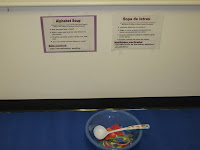
¡Feliz Día de Acción de Gracias - Gobble, gobble! This week the Village Branch will close early on Wednesday night, so we celebrated Thanksgiving early at Bilingual Family Storytime.
A colleague, Lowena Latiff, shared a song called "Mr. Turkey" with me which I translated into a rhyme to use with our beautiful Folkmanis turkey puppet. I know that all children's librarians already know this, but
Folkmanis puppets are truly the best. We used our turkey friend for a fun fingerplay too. Thanks to Raul Garces for helping me edit my translations.
Mr. Turkey
I heard Mr. Turkey say
"Gobble, gobble, gobble.
Soon will be Thanksgiving Day,
gobble, gobble, gobble.
You may think that it is fun
But I think, I will run
And hide until the day is done
Gobble, gobble, gobble."
Señor Pavo
Oí a Señor Pavo
Dice “Gobble, gobble, gobble,
El día de gracias viene pronto
El día que me asusta tonto
Para tí es divertido
Pero me da mucho miedo
Entonces voy a esconderme
Hasta que este día termine
Gobble, gobble, gobble.”
Y se fue el Señor Pavo.
Five Little Turkeys
Five little turkeys standing at the door,
one waddled off, and then there were four.
Four little turkeys sitting near a tree,
one waddled off, and then there were three.
Three little turkeys with nothing to do,
one waddled off, and then there were two.
Two little turkeys in the morning sun,
one waddled off, and then there was one.
One little turkey better run away,
For soon it will be Thanksgiving Day.
Cinco pavos
Acerca de la puerta son cinco pavos
Uno se salió, y ahora son cuatro.
Cuatro pavos gordos huelen a los postres
Uno se salió y ahora son tres.
Tres pequeños pavos saltan unos saltos
Uno se salió y ahora son dos.
Dos pavos nerviosos esperan su oportuno
Uno se salió y ahora solo hay uno.
Un pavo queda este día importuno
Cuando el se sale, ¡no hay ninguno!
We merged the theme of Thansgiving with family, as there are not a lot of good bilingual read alouds on the theme of Thanksgiving. The book that works the best, of course, is Pat Mora's
Gracias = Thanks, which is what we read first. We then read
We Are Cousins = Somos primos by Diane Gonzales Bertrand. After all, for close-knit families, your cousins are your default best friends, and for other families, Thanksgiving may be one of the few times of year when you visit with your cousins. Then we had a lot of fun singing and dancing to
José-Luis Orozco's version of "
La tía Mónica." I was hesitant to use this book at first (even though it is very interactive and builds body part vocabulary) because it is so long (about 5 minutes). However, I am so glad that I did. The families had a blast! This is definitely one to work into your regular bilingual storytime music rotation! We closed with
Juanito Counts to Ten = Johnny cuenta hasta diez by Lee Merrill Byrd. In this cute story, Juanito counts out kisses to the various people in his family and daily life, and we practice our counting in English and Spanish, helping to develop important Kindergarten Readiness skills.
So even though I will be enjoying my Thanksgiving with a
Tofurkey instead of a turkey, I hope everyone has a wonderful holiday spent relaxing with the ones you love in however many languages you live.

















